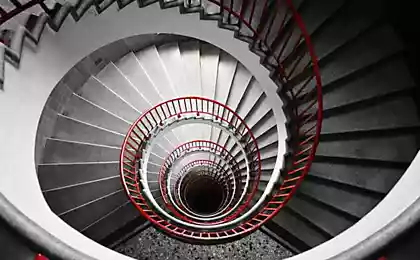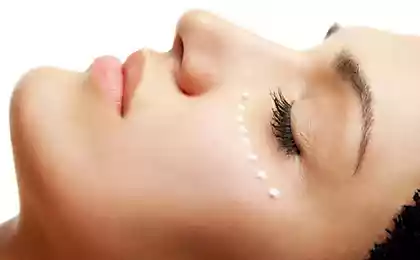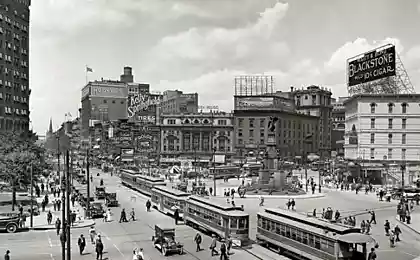3035
Historical photos of 1913
In this collection you presented for historical photographs in 1913. This year is known to the Russian Empire, the last year of peace, with indicators which will then compare the achievements of the Soviet state. It is also known that the main event of the year for Russia was a magnificent celebration of the 300th anniversary of the Romanov dynasty. Portrait of the Khan of Khiva, Sayyid Asfendiara Bogadura made in the Winter Palace February 21, 1913 at the reception to mark the anniversary of the dynasty.

Unfortunately, in 1913, Prokudin-Gorsky already thrown his ambitious project to document in the color of the Russian Empire and filmed only on special occasions. In particular, it captures details of the second All-Russia handicraft exhibition, which was held in St. Petersburg in 1913.
Here are some of the most interesting pictures.

Furniture Abramtsevo workshop has, rather, in an international style of the time:

Toys for the 300th anniversary of the Romanov House. Similarly, in a suit, as on the doll right, Nicholas II was photographed during the festivities.

Just a couple of color photographs Russia in 1913 can be seen at the French photographer Stephen Passy, who in 1913 made his second trip to Mongolia and China.
Two riders, Buryatia Troitskosavsk, a provincial town in the Trans-Baikal region 4 miles from the Chinese granitsy.Takaya wilderness, and a lantern in the street electric!

Two soldiers Cossack in Urga:

Russian soldiers in the Mongolian Urga (now Ulan Bator) Frenchman took no accident. In 1913, Mongolia - a protectorate of the Russian Empire. This was a very short period.
Here Mongolian portable prison. According to the signature, the woman sentenced to death by starvation.

The Mongols were then, as 1000 years before that, purely nomadic people. The role of capital played a large parking lot nomads, formed around a Buddhist monastery in Urga:

Mongol hunter in the vicinity of Urga:
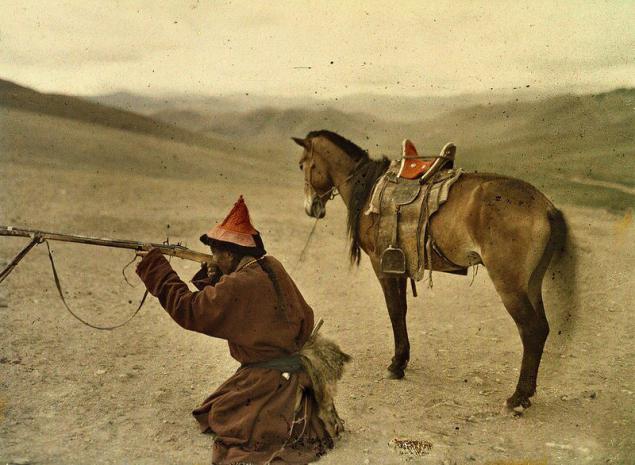
Buddhist monk in Beijing May 26, 1913, Stephen Passy:

Although 1913 was relatively peaceful, in the "powder keg of Europe" in the Balkans have the flame. First, a coalition of Balkan countries took away her last Ottoman Empire almost to the possession of Constantinople, then yesterday's allies clashed with each other. Bulgarian soldiers participating Balkan Wars 1913:
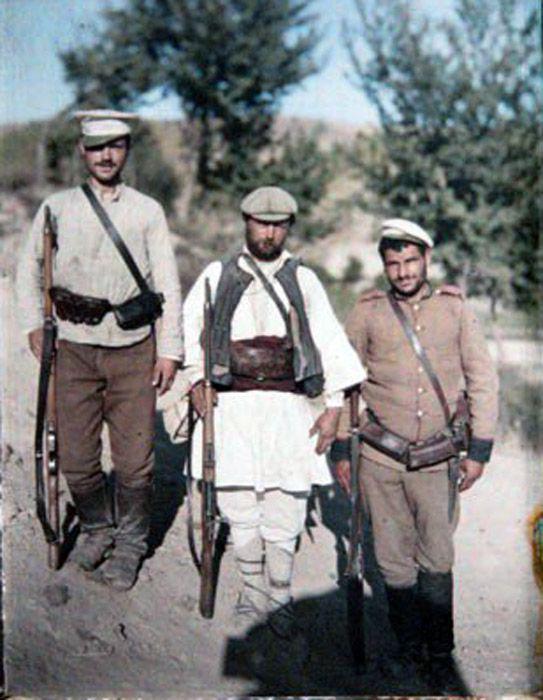
Greeks have caught a spy in the area of Mount Athos:

Greek military 1913:

Refugees from the Turkish population of Adrianople (Edirne), to leave the city at the approach of the Bulgarian Army:

Melnik town in Bulgaria. Refugees from the Ottoman Empire after the Balkan War:

Greek city of Thessaloniki, 1913:
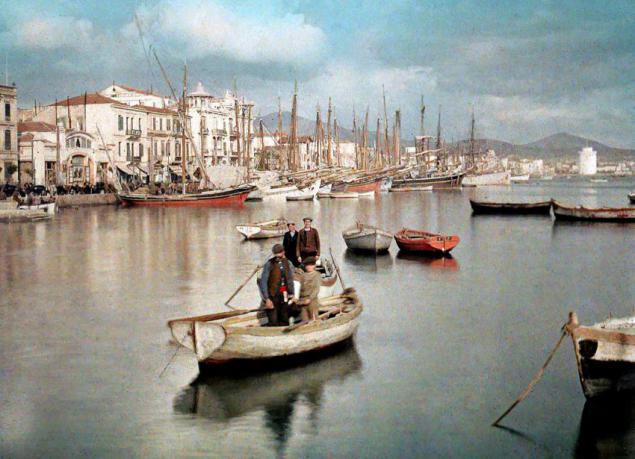
Shopping street in the Turkish city of Bursa:

In general, 1913 was exceptionally rich in ethnographic color photography, thanks to the running in 1912 draft banker and philanthropist Albert Kahn, who decided to capture on Autochrome plates all over the world. Then it was disenfranchised British colony with a population of endangered and hopeless poverty in the villages. In this case, the villagers, to a much greater extent than the city, by the time the persistence of traditional Irish culture.
This saw the photos (Mespoulet and Mignon) Irish outback in 1913:

Irish peasants:

Girl in old Irish costume:
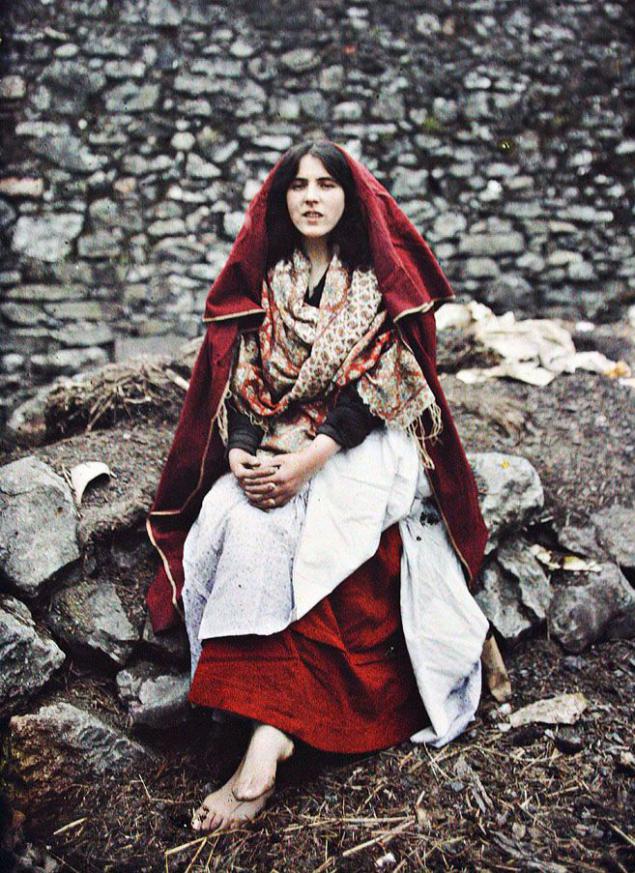
However, and in England met-poor villages.
Village in Cornwall in the picture Leon Auguste 1913:

Compare this to a typical English bourgeois quarter of 1913 .:

And so the townspeople lived simpler, street in the town of St. Ives:
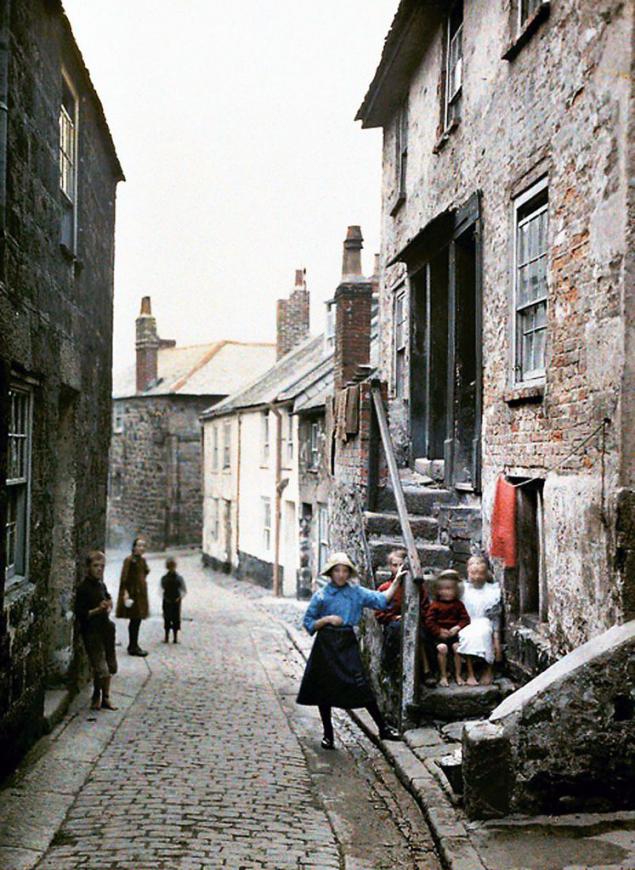
A little more of Europe in 1913.
Market in Paris:

The Church of Saint-Walburgachurch in Oudenaarde, Belgium:

In the port of Genoa:

Sellers lemonade in Belgrade:

By 1913, flourished transoceanic shipping, especially in the Atlantic, which scoured the tens and hundreds of luxury liners.
Steamboat BERMUDIAN in Hamilton Harbour in Bermuda 1913:
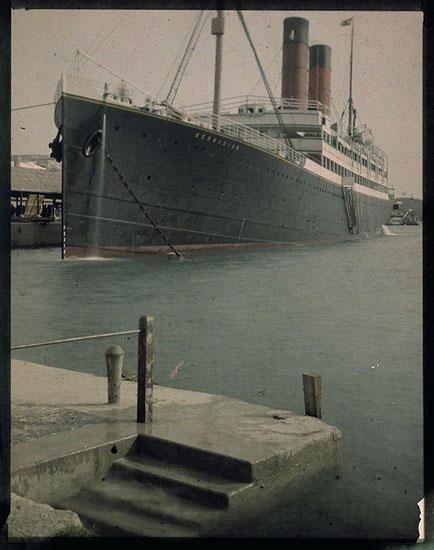
Americans almost added onto the Panama Canal, which will be opened in the next, 1914:
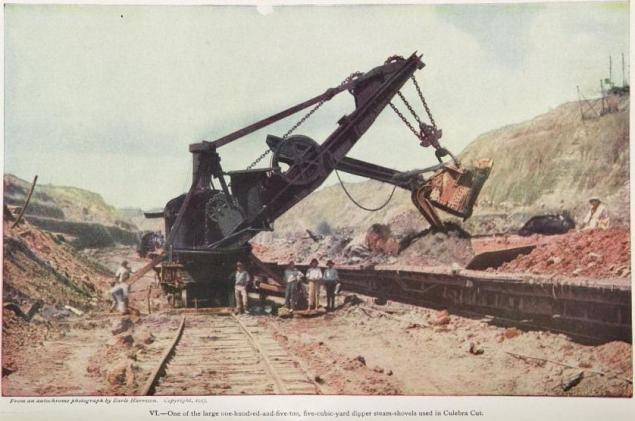
Again, go back to Asia.
Residents of Indian Agri pictured Stephen Passy, 1913:
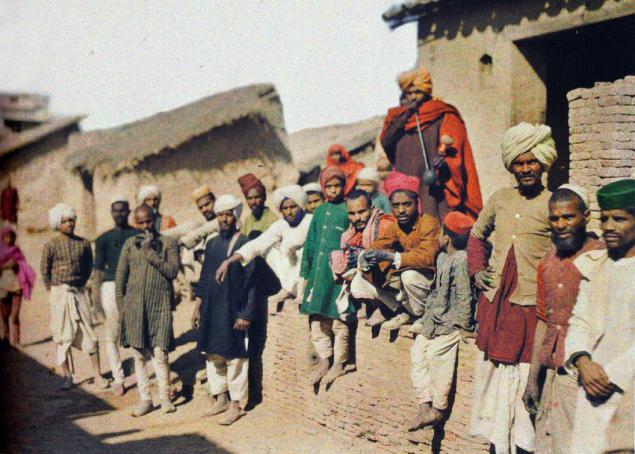
Taj Mahal 100 years ago was the same:

On the street in Bombay in 1913:
And a little bit of Africa in 1913.
Senegalese arrows near the city of Fez in Morocco in a picture of the same Stephen Passy:
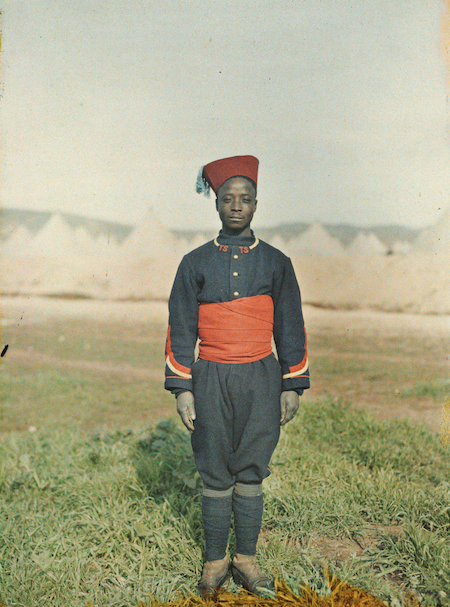
Moroccans:
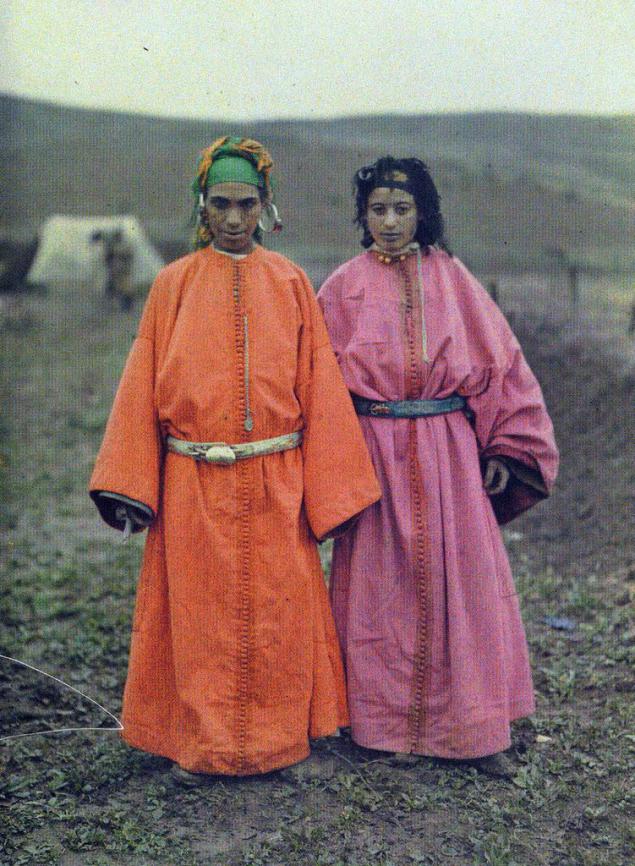
Source: visualhistory.livejournal.com

Unfortunately, in 1913, Prokudin-Gorsky already thrown his ambitious project to document in the color of the Russian Empire and filmed only on special occasions. In particular, it captures details of the second All-Russia handicraft exhibition, which was held in St. Petersburg in 1913.
Here are some of the most interesting pictures.

Furniture Abramtsevo workshop has, rather, in an international style of the time:

Toys for the 300th anniversary of the Romanov House. Similarly, in a suit, as on the doll right, Nicholas II was photographed during the festivities.

Just a couple of color photographs Russia in 1913 can be seen at the French photographer Stephen Passy, who in 1913 made his second trip to Mongolia and China.
Two riders, Buryatia Troitskosavsk, a provincial town in the Trans-Baikal region 4 miles from the Chinese granitsy.Takaya wilderness, and a lantern in the street electric!

Two soldiers Cossack in Urga:

Russian soldiers in the Mongolian Urga (now Ulan Bator) Frenchman took no accident. In 1913, Mongolia - a protectorate of the Russian Empire. This was a very short period.
Here Mongolian portable prison. According to the signature, the woman sentenced to death by starvation.

The Mongols were then, as 1000 years before that, purely nomadic people. The role of capital played a large parking lot nomads, formed around a Buddhist monastery in Urga:

Mongol hunter in the vicinity of Urga:

Buddhist monk in Beijing May 26, 1913, Stephen Passy:

Although 1913 was relatively peaceful, in the "powder keg of Europe" in the Balkans have the flame. First, a coalition of Balkan countries took away her last Ottoman Empire almost to the possession of Constantinople, then yesterday's allies clashed with each other. Bulgarian soldiers participating Balkan Wars 1913:

Greeks have caught a spy in the area of Mount Athos:

Greek military 1913:

Refugees from the Turkish population of Adrianople (Edirne), to leave the city at the approach of the Bulgarian Army:

Melnik town in Bulgaria. Refugees from the Ottoman Empire after the Balkan War:

Greek city of Thessaloniki, 1913:

Shopping street in the Turkish city of Bursa:

In general, 1913 was exceptionally rich in ethnographic color photography, thanks to the running in 1912 draft banker and philanthropist Albert Kahn, who decided to capture on Autochrome plates all over the world. Then it was disenfranchised British colony with a population of endangered and hopeless poverty in the villages. In this case, the villagers, to a much greater extent than the city, by the time the persistence of traditional Irish culture.
This saw the photos (Mespoulet and Mignon) Irish outback in 1913:

Irish peasants:

Girl in old Irish costume:

However, and in England met-poor villages.
Village in Cornwall in the picture Leon Auguste 1913:

Compare this to a typical English bourgeois quarter of 1913 .:

And so the townspeople lived simpler, street in the town of St. Ives:

A little more of Europe in 1913.
Market in Paris:

The Church of Saint-Walburgachurch in Oudenaarde, Belgium:

In the port of Genoa:

Sellers lemonade in Belgrade:

By 1913, flourished transoceanic shipping, especially in the Atlantic, which scoured the tens and hundreds of luxury liners.
Steamboat BERMUDIAN in Hamilton Harbour in Bermuda 1913:

Americans almost added onto the Panama Canal, which will be opened in the next, 1914:

Again, go back to Asia.
Residents of Indian Agri pictured Stephen Passy, 1913:

Taj Mahal 100 years ago was the same:

On the street in Bombay in 1913:
And a little bit of Africa in 1913.
Senegalese arrows near the city of Fez in Morocco in a picture of the same Stephen Passy:

Moroccans:

Source: visualhistory.livejournal.com



